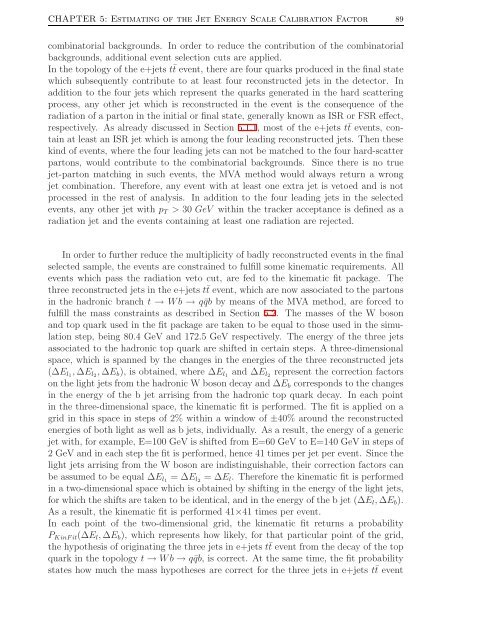Measurement of the Jet Energy Scale in the CMS experiment ... - IIHE
Measurement of the Jet Energy Scale in the CMS experiment ... - IIHE
Measurement of the Jet Energy Scale in the CMS experiment ... - IIHE
Create successful ePaper yourself
Turn your PDF publications into a flip-book with our unique Google optimized e-Paper software.
CHAPTER 5: Estimat<strong>in</strong>g <strong>of</strong> <strong>the</strong> <strong>Jet</strong> <strong>Energy</strong> <strong>Scale</strong> Calibration Factor 89comb<strong>in</strong>atorial backgrounds. In order to reduce <strong>the</strong> contribution <strong>of</strong> <strong>the</strong> comb<strong>in</strong>atorialbackgrounds, additional event selection cuts are applied.In <strong>the</strong> topology <strong>of</strong> <strong>the</strong> e+jets t¯t event, <strong>the</strong>re are four quarks produced <strong>in</strong> <strong>the</strong> f<strong>in</strong>al statewhich subsequently contribute to at least four reconstructed jets <strong>in</strong> <strong>the</strong> detector. Inaddition to <strong>the</strong> four jets which represent <strong>the</strong> quarks generated <strong>in</strong> <strong>the</strong> hard scatter<strong>in</strong>gprocess, any o<strong>the</strong>r jet which is reconstructed <strong>in</strong> <strong>the</strong> event is <strong>the</strong> consequence <strong>of</strong> <strong>the</strong>radiation <strong>of</strong> a parton <strong>in</strong> <strong>the</strong> <strong>in</strong>itial or f<strong>in</strong>al state, generally known as ISR or FSR effect,respectively. As already discussed <strong>in</strong> Section 5.1.1, most <strong>of</strong> <strong>the</strong> e+jets t¯t events, conta<strong>in</strong>at least an ISR jet which is among <strong>the</strong> four lead<strong>in</strong>g reconstructed jets. Then <strong>the</strong>sek<strong>in</strong>d <strong>of</strong> events, where <strong>the</strong> four lead<strong>in</strong>g jets can not be matched to <strong>the</strong> four hard-scatterpartons, would contribute to <strong>the</strong> comb<strong>in</strong>atorial backgrounds. S<strong>in</strong>ce <strong>the</strong>re is no truejet-parton match<strong>in</strong>g <strong>in</strong> such events, <strong>the</strong> MVA method would always return a wrongjet comb<strong>in</strong>ation. Therefore, any event with at least one extra jet is vetoed and is notprocessed <strong>in</strong> <strong>the</strong> rest <strong>of</strong> analysis. In addition to <strong>the</strong> four lead<strong>in</strong>g jets <strong>in</strong> <strong>the</strong> selectedevents, any o<strong>the</strong>r jet with p T > 30 GeV with<strong>in</strong> <strong>the</strong> tracker acceptance is def<strong>in</strong>ed as aradiation jet and <strong>the</strong> events conta<strong>in</strong><strong>in</strong>g at least one radiation are rejected.In order to fur<strong>the</strong>r reduce <strong>the</strong> multiplicity <strong>of</strong> badly reconstructed events <strong>in</strong> <strong>the</strong> f<strong>in</strong>alselected sample, <strong>the</strong> events are constra<strong>in</strong>ed to fulfill some k<strong>in</strong>ematic requirements. Allevents which pass <strong>the</strong> radiation veto cut, are fed to <strong>the</strong> k<strong>in</strong>ematic fit package. Thethree reconstructed jets <strong>in</strong> <strong>the</strong> e+jets t¯t event, which are now associated to <strong>the</strong> partons<strong>in</strong> <strong>the</strong> hadronic branch t → Wb → q¯qb by means <strong>of</strong> <strong>the</strong> MVA method, are forced t<strong>of</strong>ulfill <strong>the</strong> mass constra<strong>in</strong>ts as described <strong>in</strong> Section 5.2. The masses <strong>of</strong> <strong>the</strong> W bosonand top quark used <strong>in</strong> <strong>the</strong> fit package are taken to be equal to those used <strong>in</strong> <strong>the</strong> simulationstep, be<strong>in</strong>g 80.4 GeV and 172.5 GeV respectively. The energy <strong>of</strong> <strong>the</strong> three jetsassociated to <strong>the</strong> hadronic top quark are shifted <strong>in</strong> certa<strong>in</strong> steps. A three-dimensionalspace, which is spanned by <strong>the</strong> changes <strong>in</strong> <strong>the</strong> energies <strong>of</strong> <strong>the</strong> three reconstructed jets(∆E l1 , ∆E l2 , ∆E b ), is obta<strong>in</strong>ed, where ∆E l1 and ∆E l2 represent <strong>the</strong> correction factorson <strong>the</strong> light jets from <strong>the</strong> hadronic W boson decay and ∆E b corresponds to <strong>the</strong> changes<strong>in</strong> <strong>the</strong> energy <strong>of</strong> <strong>the</strong> b jet arris<strong>in</strong>g from <strong>the</strong> hadronic top quark decay. In each po<strong>in</strong>t<strong>in</strong> <strong>the</strong> three-dimensional space, <strong>the</strong> k<strong>in</strong>ematic fit is performed. The fit is applied on agrid <strong>in</strong> this space <strong>in</strong> steps <strong>of</strong> 2% with<strong>in</strong> a w<strong>in</strong>dow <strong>of</strong> ±40% around <strong>the</strong> reconstructedenergies <strong>of</strong> both light as well as b jets, <strong>in</strong>dividually. As a result, <strong>the</strong> energy <strong>of</strong> a genericjet with, for example, E=100 GeV is shifted from E=60 GeV to E=140 GeV <strong>in</strong> steps <strong>of</strong>2 GeV and <strong>in</strong> each step <strong>the</strong> fit is performed, hence 41 times per jet per event. S<strong>in</strong>ce <strong>the</strong>light jets arris<strong>in</strong>g from <strong>the</strong> W boson are <strong>in</strong>dist<strong>in</strong>guishable, <strong>the</strong>ir correction factors canbe assumed to be equal ∆E l1 = ∆E l2 = ∆E l . Therefore <strong>the</strong> k<strong>in</strong>ematic fit is performed<strong>in</strong> a two-dimensional space which is obta<strong>in</strong>ed by shift<strong>in</strong>g <strong>in</strong> <strong>the</strong> energy <strong>of</strong> <strong>the</strong> light jets,for which <strong>the</strong> shifts are taken to be identical, and <strong>in</strong> <strong>the</strong> energy <strong>of</strong> <strong>the</strong> b jet (∆E l , ∆E b ).As a result, <strong>the</strong> k<strong>in</strong>ematic fit is performed 41×41 times per event.In each po<strong>in</strong>t <strong>of</strong> <strong>the</strong> two-dimensional grid, <strong>the</strong> k<strong>in</strong>ematic fit returns a probabilityP K<strong>in</strong>Fit (∆E l , ∆E b ), which represents how likely, for that particular po<strong>in</strong>t <strong>of</strong> <strong>the</strong> grid,<strong>the</strong> hypo<strong>the</strong>sis <strong>of</strong> orig<strong>in</strong>at<strong>in</strong>g <strong>the</strong> three jets <strong>in</strong> e+jets t¯t event from <strong>the</strong> decay <strong>of</strong> <strong>the</strong> topquark <strong>in</strong> <strong>the</strong> topology t → Wb → q¯qb, is correct. At <strong>the</strong> same time, <strong>the</strong> fit probabilitystates how much <strong>the</strong> mass hypo<strong>the</strong>ses are correct for <strong>the</strong> three jets <strong>in</strong> e+jets t¯t event
















